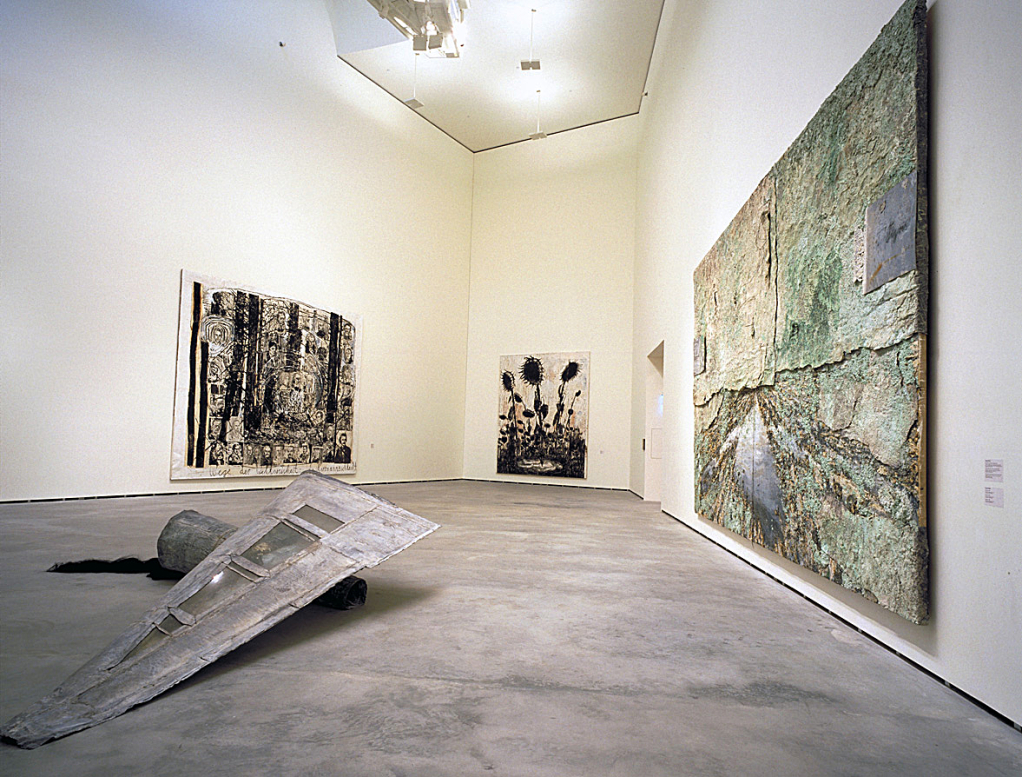The Guggenheim Museums and the Art of This Century
10.19.1997 - 06.01.1998
The Guggenheim Museums and the Art of This Century is the exhibition with which the Guggenheim Museum Bilbao first opened its doors to the public on October 19, 1997. It features a magnificent selection of over 250 20th-century works of art primarily from the collections of the Solomon R. Guggenheim Foundation and the Guggenheim Museum Bilbao.
The Solomon R. Guggenheim Foundation's collection was begun in the late 1920s by Solomon R. Guggenheim with the assistance of his art adviser, Baroness Hilla Rebay. Their acquisitions policy was initially based on a commitment to a specific aesthetic criterion: non-objective, or abstract, art. Later however, through an intense program of acquisitions and donations, the early collection consisting primarily of paintings by Kandinsky began to expand beyond the initial aesthetic criterion until it became what it is today—a collection of thousands of works of art representing a vast range of artists and stylistic trends of the 20th century.
The works in the recently created collection of the Guggenheim Museum Bilbao complement the permanent collection of the prestigious Solomon R. Guggenheim Foundation and form the nucleus of an independent, coherent and widely representative selection of works created since mid-century. Among the acquisitions of the Guggenheim Museum Bilbao included in the opening exhibition are works by some of the foremost artists of this period, such as Eduardo Chillida, Anselm Kiefer, Willem de Kooning, Robert Motherwell, Mark Rothko, and Antoni Tàpies.
Some of the galleries of the Frank Gehry-designed Museum feature site-specific works created especially for the Guggenheim Museum Bilbao by contemporary European and American artists such as Francesco Clemente, Jenny Holzer, Sol LeWitt, and Richard Serra. Such projects foster dialogue between art and the art institution, promoting and enhancing the new architectural spaces that depart from the discrete, "neutral" proportions of the traditional gallery.
In addition, other spaces in the Museum feature comprehensive selections of work by certain artists of singular importance in the history of 20th-century art, such as Joseph Beuys and Vasily Kandinsky, thus enabling the visitor to view their oeuvres in greater depth.
Chronologically, The Guggenheim Museums and the Art of This Century begins with a diverse selection of masterpieces of European art from the first three decades of the 20th century. A selection of works from the Solomon R. Guggenheim Museum of New York and from the Peggy Guggenheim Collection in Venice allows one to appreciate the decisive role played by European avant-garde movements in the development of the art of our century. Works by the foremost representatives of Cubism, Futurism, Constructivism, German Expressionism, and Surrealism, among others, show how these movements broke with tradition and the constraints of the 19th century to create the basis for a new language of art that was to develop throughout the present century. Featured artists include Georges Braque, Constantin Brancusi, Marc Chagall, Fernand Léger, Vasily Kandinsky, Paul Klee, Kazimir Malevich, Henri Matisse, Amedeo Modigliani, Joan Miró, Piet Mondrian, Pablo Picasso, and Gino Severini.
The survey of the history of 20th-century art continues with the mid-century developments in European and American art, establishing a dialogue between the artists of the two continents. Works by Clyfford Still, Mark Rothko, Willem de Kooning, Robert Motherwell reflect the efforts of Abstract Expressionism to bring together form and emotion, while the major European contemporaries of Abstract Expressionism focus their interest primarily on materials. Outstanding among these European artists are Alberto Burri, Jean Dubuffet, and Tàpies (the primary representatives of Art Informel); Lucio Fontana; Asger Jorn; and the creator of Nouveau Réalisme, Yves Klein. Also highlighted are four recent works by Chillida, one of the most distinguished sculptors on the contemporary scene.
In addition, a small gallery displays an exquisite grouping of works on paper by Alberto Giacometti, Arshile Gorky, and Ellsworth Kelly from the collection of the Solomon R. Guggenheim Museum.
The major American movements during the 1960s and 1970s are represented in this exhibition by outstanding examples of Pop art, including works by Roy Lichtenstein, Claes Oldenburg and Coosje van Bruggen, and Andy Warhol; and Minimalist works by Carl Andre, Donald Judd, and Robert Morris.
European art of the last two decades is represented by the works of Mario Merz and Jannis Kounellis (representatives of Arte Povera), Richard Long, and Christian Boltanski, a selection that enables the visitor to see the enormous variety of techniques and materials used in today's art. These newer forms coexist with slightly older ones, such as the enigmatic sculpture of Magdalena Abakanowicz and the paintings of Georg Baselitz, Enzo Cucchi, Sigmar Polke, Gerhard Richter, and Julian Schnabel. Also included are video-based work, with examples by Stan Douglas and Bill Viola. Finally, younger Basque and Spanish artists are represented in the collection of the Guggenheim Museum Bilbao through works by Txomin Badiola, Miquel Barceló, Cristina Iglesias, and Juan Muñoz.
With its wide range of 20th-century artists, movements and artistic mediums, The Guggenheim Museums and the Art of This Century is an exhibition that enables the visitor to survey the art of our century from its origins to its finest achievements and to reflect on what the future may bring in the art of the century to come.
Curatorial Department Guggenheim Museum Bilbao
A gallery dedicated to Anselm Kiefer at The Guggenheim Museums and the Art of this Century exhibition. In the foreground, right: The Land of the Two Rivers (Zweistromland, 1995); left: Berenice, 1989; farther back: The Paths of World Wisdom: Hermann’s Battle (Wege der Weltweisheit: die Hermannsschlacht, 1995). In the background: Sunflowers (Tournesols, 1996)

